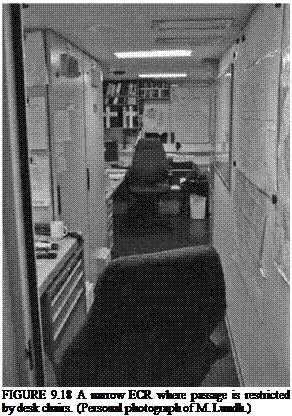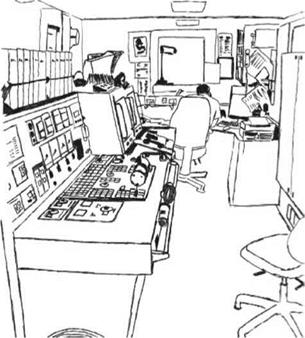The greatest challenge is, of course, the design of small ECRs. The smaller the available space, the more thought must be spent in the design. If not, the work in the ECR risks becoming restrained through overcrowding (if more than one crew member is present) or inefficient (if a solitary crew member cannot reach all the controls and equipment needed). Figure 9.18 and Figure 9.19 show a suggested layout for the smaller ECR, again fitting in the basic functions.
The tasks that are performed in the ECR have changed in recent years and nowadays engineers have to perform more computer-based tasks than before. If the crew is so few in number that administrative work must be performed during the control room watch, the layout of the ECR must take this into consideration and provide a desk. However, one should be aware that this may contradict the suggestions in
|
Planning and documen tation |
Safety |
Monitoring |
Communi cation |
|
Emergency operation |
Normal operation |
Adm. duties |
|
|
Stand-by area |
|
Suggested layout for a small ECR, with basic functions. Table 9.4, aim 1.6: ‘Preventing or minimising excessive or unnecessary work and any conditions or distractions in the ECR which might cause fatigue or interfere with the vigilance of the ECR team’. If it is still deemed necessary, the layout should allow administrative work to be performed while the engineer still has a good overview of process and alarm information and can reach the acknowledgement button to the alarm system. Figure 9.20 shows an example of the opposite. |
 |
FIGuRE 9.19
|
FIGURE 9.20 A narrow desk in the ECR which is in a corner. This leaves the engineer with his back to the operating panels and the alarm system. (Drawing by E. Jacobson from a photograph. With permission.) |
It is also important to have a briefing area where meetings with the engine room crew can take place. The ECR is the area where discussions and sharing of information can take place without risk of misunderstandings due to the noise level in the engine room. The engine crew also need a stand-by area where they can relax and take a break from the noisy and hot environment, which in many cases the engine room represents (see Figure 9.21). The area can, for instance, also be used by a standby engineer waiting for a departure or waiting in a lock.




